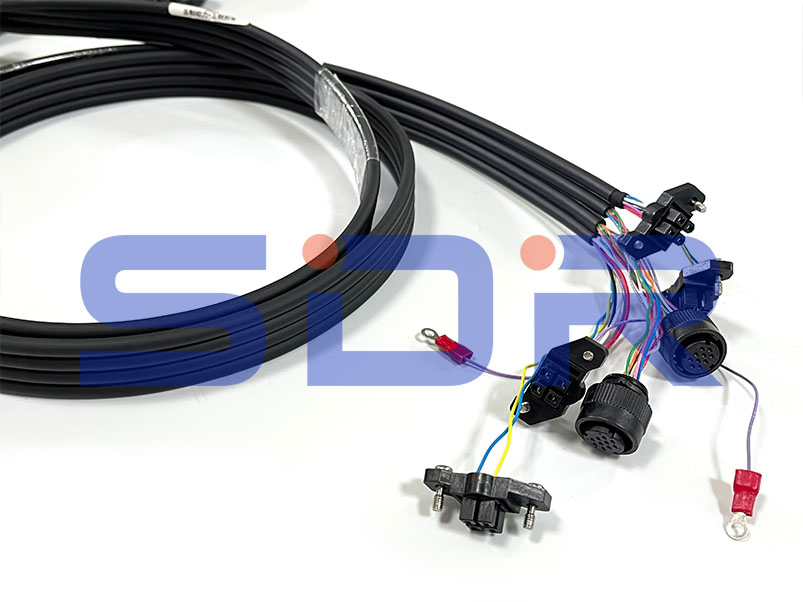The POWER CABLE is a critical component for the proper operation of the Fanuc 10ia robot. Maintenance of the power cable is critical to ensure that the robot can operate stably for a long period of time.

1. Periodic inspection
a. Visual inspection
Perform a detailed visual inspection once a week to look for the following conditions on the cable surface:
Wear and tear: whether there are obvious signs of wear and tear on the surface.
Cracks: whether there are cracks in the cable insulation.
Twisting: whether the cable is abnormally twisted or deformed.
Discoloration: Whether there is discoloration of the insulation, which may be caused by overheating or chemical corrosion.
If any abnormalities are found, such as broken insulation and exposed wires, they should be dealt with immediately and the cable may need to be replaced.
b. Connector Inspection
Check the connectors at both ends of the cable monthly to ensure that they are:
No looseness: the connectors are tightly connected to the equipment with no signs of looseness.
No damage: the metal parts of the connector are not corroded or damaged and the plastic parts are not cracked.
Clean: the connector is free of dust and dirt inside and on the surface.
If there is a problem with the connector, the connector can be cleaned or replaced to ensure a reliable electrical connection.
2. Proper Installation
a. Avoid excessive bending
Pay attention to the bending radius of the cable during installation and use:
Bending radius: The bending radius should be as large as possible, generally not less than 5 times the diameter of the cable. Excessive bending will result in damage to the internal conductors.
Bending position: Avoid bending near the fixing points and connectors of the cable, these positions should be kept straight to reduce stress concentration.
b. Securing the cable
Use appropriate fixings to keep the cable stable:
Cable clamps: Use cable clamps or ties to secure the cable to the machine or bench to avoid overhanging the cable.
Cable troughs: Use cable troughs to protect cables when needed to prevent them from moving or being affected by external forces during work.
3. Environmental protection
a. Protection from contact with sharp objects
Ensure that Cables are kept away from sharp objects and equipment:
Protective sleeving: Use protective sleeving where cables may come into contact with sharp objects.
Cable trays: Install cable trays in the path of the cable so that it hangs in a safe position.
b. Temperature control
Control the temperature of the environment in which the cable operates:
Temperature range: Ensure that the ambient temperature is within the rated temperature range of the cable, usually -20°C to 80°C.
Heat source protection: Avoid placing the cable near hot equipment or exposing it to direct sunlight. Thermal insulation can be used to protect the cable.
4. Periodic Cleaning
a. Remove dust and dirt
Keep the cable clean to avoid accumulation of dust and dirt:
Cleaning method: Use a dry cloth or special cable cleaner to gently wipe the cable surface. Do not use cleaners containing caustic chemicals.
Frequency: Clean at least once a quarter, and increase the cleaning frequency appropriately according to the environmental conditions.
b. Check for corrosion
Especially in humid or chemical environments, check the cable regularly for corrosion:
Surface corrosion: Check the cable surface for corrosion spots.
Connector corrosion: focus on checking the connector part, if corrosion is found, clean it immediately and take protective measures, such as applying anticorrosion agent or replacing the connector.
5. Professional maintenance
a. Regular professional inspection
Arrange for professional personnel to conduct a comprehensive inspection of the cable:
Inspection frequency: quarterly or semi-annual professional inspection.
Inspection content: including insulation resistance test, conductivity test and structural integrity check of cables.
b. Record maintenance
Detailed records of each inspection and maintenance should be made during the maintenance process:
Record content: including problems found, measures taken, parts replaced and maintenance date.
Tracking history: Maintenance records can be used to track the use of cables and prevent potential problems in advance.
6. Emergency Handling
a. Emergency Replacement
Stop the robot immediately when serious damage or abnormal functioning of the cable is detected:
Replacement procedure: Turn off the power of the robot, remove the damaged cable, install the new cable, and make sure the connection is secure before restarting the robot.
Inspection: After replacement, a full inspection should be carried out to ensure that the new cable works properly.
b. Spare cables
It is recommended that enterprises reserve a certain number of spare cables:
Quantity: Depending on the number of robots and work intensity, reserve enough spare cables.
Storage conditions: Spare cables should be stored in a dry, light-proof environment, avoiding moisture and direct sunlight.
With the above methods and detailed suggestions, you can effectively extend the service life of Fanuc 10ia Robot Power Cables to ensure stable operation of the robot and improve productivity. Regular inspection and maintenance can not only prevent problems from occurring, but also solve them in time when they first appear to avoid affecting production.